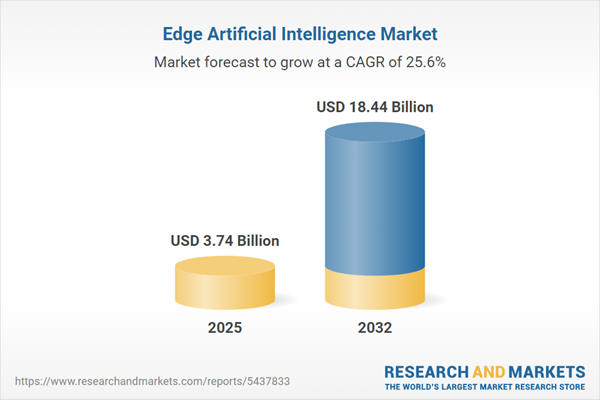Speak directly to the analyst to clarify any post sales queries you may have.
Edge artificial intelligence is transforming how enterprises operate by enabling immediate insights and actions at the data source. Senior decision-makers in highly regulated and complex industries are increasingly leveraging edge AI to boost agility, ensure ongoing compliance, and strengthen business resilience amid digital evolution.
Market Snapshot: Edge Artificial Intelligence Growth
The Edge Artificial Intelligence (AI) market is undergoing rapid growth, fueled by sustained investment in digital transformation and a rising demand for real-time analytics across distributed operational points. In 2024, the edge AI market reached USD 2.97 billion, with a projected expansion to USD 3.74 billion in 2025. Expectations indicate further accelerated growth to USD 18.44 billion by 2032, at a compound annual growth rate (CAGR) of 25.61%. Key sectors, including automotive, healthcare, manufacturing, retail, and utilities, are deploying edge AI to increase operational efficiency, manage strict regulatory environments, and maintain business flexibility. Providers continue developing advanced hardware alongside integrated edge platforms, supporting seamless, compliant, and unified operations across diverse geographies.
Scope & Segmentation of the Edge Artificial Intelligence Market
- Component: Hardware accelerators, processors, memory modules, storage units, middleware, and software for real-time data management. Providers also supply managed and professional services designed to ensure system reliability in mission-critical scenarios.
- End Use Industry: Automotive, consumer electronics, energy, utilities, healthcare, manufacturing, retail, and ecommerce, where edge AI supports monitoring, diagnostics, and analytics to drive efficiency and optimize results.
- Application: Fraud detection, anomaly identification, advanced computer vision, object recognition, language analytics, and predictive modeling, all supporting actionable decision-making at the data’s origin.
- Deployment Mode: Cloud-based, hybrid, and on-device options deliver flexible, distributed data processing, ensuring that organizations can align with varied business and technical models—including emerging solutions for mobile and embedded devices.
- Processor Type: ASICs, Arm CPUs, x86 CPUs, FPGAs, DSPs, integrated GPUs, and discrete GPUs, each tailored for high-performance, low-latency machine learning applications within edge environments.
- Node Type: Edge devices, gateways, routers, and network-edge computing units, which streamline data handling close to operational assets while limiting reliance on centralized systems.
- Connectivity Type: Secure protocols—such as 5G, LPWAN, Ethernet, and Wi-Fi—enable fast, reliable business data exchanges suitable for distributed and diverse operational footprints.
- AI Model Type: Deep learning, neural networks, transformers, and classic machine learning algorithms, all engineered to deliver business intelligence directly at the point of data collection.
- Geography: Americas, Europe, Middle East & Africa, and Asia-Pacific, each with distinct adoption maturity and regulatory landscapes influencing technology rollout and strategy development.
- Key Companies: NVIDIA Corporation, Intel Corporation, Qualcomm Incorporated, Advanced Micro Devices, NXP Semiconductors, Texas Instruments, MediaTek, Samsung Electronics, Microchip Technology, and Lattice Semiconductor. These companies drive innovation in foundational technologies, shaping the edge AI ecosystem.
Key Takeaways for Decision-Makers
- Edge artificial intelligence enables enterprises to make faster, data-driven decisions at operational endpoints, helping leaders address industry shifts with greater responsiveness.
- Local data processing minimizes risks related to privacy and regulatory compliance, especially in industries facing complex data security and governance requirements.
- Modular and flexible architectures allow organizations to respond efficiently to changing operational needs and adapt to shifting regulations without significant disruptions.
- Purpose-designed processors and robust hardware underpin advanced analytics and automation, increasing workflow efficiency and supporting business continuity plans.
- Ongoing collaboration between solution providers and industry stakeholders supports the creation of tailored edge AI solutions, enabling industries to address emerging risks and stay aligned with best practice standards.
Tariff Impact on Edge AI Ecosystem
The introduction of new tariffs on US semiconductor imports is prompting organizations to re-evaluate supply chain strategies and manage costs in edge artificial intelligence deployments. Enterprises are emphasizing local sourcing and preferring modular, hardware-independent platforms to reduce exposure to supply chain disruptions. This development is especially meaningful in sectors like automotive and healthcare, where operational reliability and security are paramount for edge AI solutions.
Methodology & Data Sources
This assessment is grounded in executive interviews and insights from industry experts, supplemented by quantitative data from leading hardware and service providers. The research references published industry studies, patent evaluations, regulatory guidance, and trusted analytical models to achieve accuracy and data integrity.
Why This Report Matters
- Empowers executives with decision-ready insights, supporting strategic agenda setting and transformative digital initiatives in edge artificial intelligence.
- Clarifies evolving regulatory trends and technology priorities, allowing organizations to prepare for change and address compliance challenges confidently.
- Guides partner selection and helps define actionable technology roadmaps for maintaining competitiveness in target sectors.
Conclusion
Edge artificial intelligence offers enterprises essential capabilities for adaptive planning, regulatory alignment, and operational resilience. Leveraging advanced edge AI fosters sustained business evolution and supports success in dynamic digital markets.
Additional Product Information:
- Purchase of this report includes 1 year online access with quarterly updates.
- This report can be updated on request. Please contact our Customer Experience team using the Ask a Question widget on our website.
Table of Contents
3. Executive Summary
4. Market Overview
7. Cumulative Impact of Artificial Intelligence 2025
Companies Mentioned
The companies profiled in this Edge Artificial Intelligence market report include:- NVIDIA Corporation
- Intel Corporation
- Qualcomm Incorporated
- Advanced Micro Devices, Inc.
- NXP Semiconductors N.V.
- Texas Instruments Incorporated
- MediaTek Inc.
- Samsung Electronics Co., Ltd.
- Microchip Technology Incorporated
- Lattice Semiconductor Corporation
Table Information
| Report Attribute | Details |
|---|---|
| No. of Pages | 199 |
| Published | October 2025 |
| Forecast Period | 2025 - 2032 |
| Estimated Market Value ( USD | $ 3.74 Billion |
| Forecasted Market Value ( USD | $ 18.44 Billion |
| Compound Annual Growth Rate | 25.6% |
| Regions Covered | Global |
| No. of Companies Mentioned | 11 |









